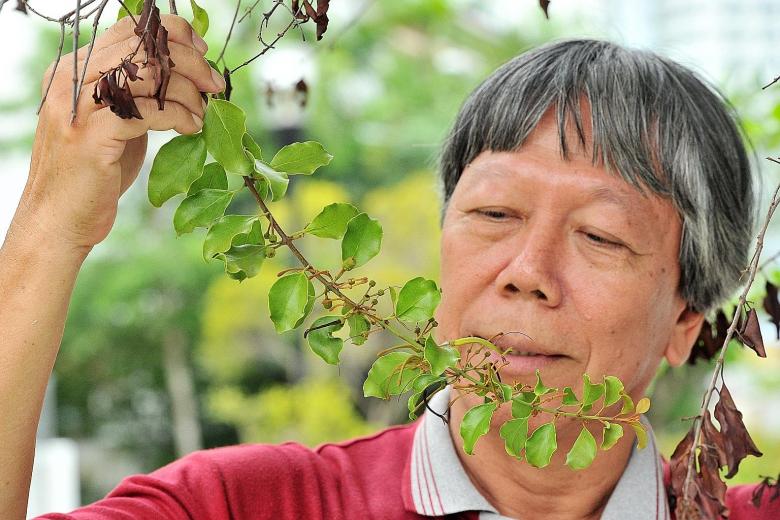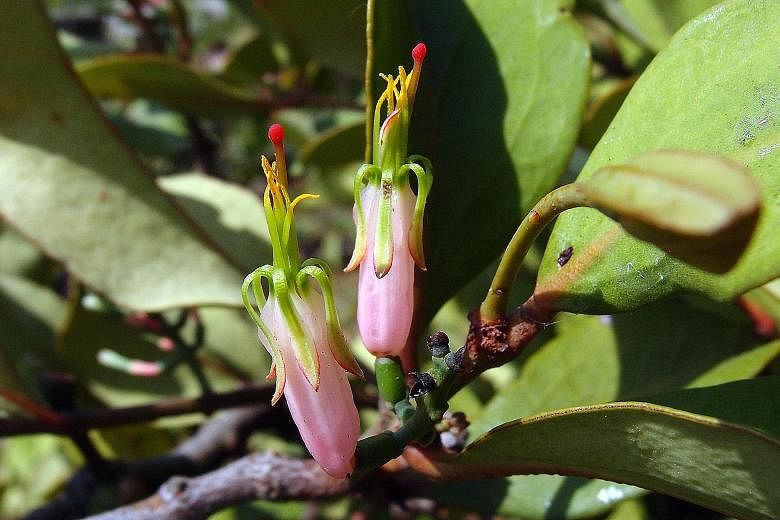Did you know that mistletoe, often associated with wintery Christmases and romance, can be found in tropical Singapore?
In fact, there are more mistletoe species here than in the whole of Britain, which has only one mistletoe species, said biologist Jean Yong of the Singapore University of Technology and Design's (SUTD's) biology faculty.
Associate Professor Yong had in October last year co-authored the book A Guide To The Common Epiphytes And Mistletoes Of Singapore with four other researchers from SUTD, National Parks Board (NParks) and NParks' Centre for Urban Greenery and Ecology.
Eight mistletoe species can be found here, down from the 14 recorded since the 1800s. The other six are presumed to be extinct.
Prof Yong said: "The extinct mistletoes were rare species growing on forest trees that were removed during land development in Singapore over the last 100 years.
-
Five species in Singapore
-
COMMON MALAYAN MISTLETOE
Dendrophthoe pentandraThis is the most common species of mistletoe in Singapore, and can be found growing on trees and shrubs along roads, in parks and gardens. This bushy plant can grow up to 2m tall, and has fruit that look like berries, which can grow up to 1.2 cm in length, and may be covered with soft hair. The leaves of this mistletoe can be pounded and used to treat sores and ulcers, and is also known as a post-childbirth medication.
-
CHRISTMAS MISTLETOE OR PINK-FLOWERED MISTLETOE
Macrosolen retususThis species of mistletoe is listed as vulnerable, with sizeable populations found only in the Southern Islands. It can also be found on a few trees at Bidadari, Changi Point, Fort Canning Park, Mount Vernon, Normanton Park and Simei. It is a short, stout shrub and has berry-like fruit that measure about 1.2cm in diameter.
-
RED FLOWER SCURRULA
Scurrula parasiticaThis is a critically endangered species of mistletoe in Singapore and is known to grow only on a mangrove tree species in Pulau Tekong, Lumnitzera littorea. It has berry-like fruit that are reddish-yellow .
-
HERBAL TAXILLUS
Taxillus chinensisThe herbal taxillus is the newest species of mistletoe to be recorded in Singapore. It was found growing on a Rose-of- India tree in East Coast Park in 2004. Now, it is considered critically endangered here due to its limited occurrence - it is found only in the eastern parts of Singapore, such as at East Coast Park, Katong and Simei. It has yellowish-brown, berry-like fruit.
-
LEAFLESS MISTLETOE
Viscum articulatumThis mistletoe is a hyper- parasite, which means it parasitises other mistletoes.
Here, it is growing on the Dendrophthoe pentandra mistletoe. It does not have leaves, instead bearing narrow, yellowish-green stems. Its fruit are berry-like and are translucent and yellowish-green. The leafless mistletoe is listed as vulnerable in Singapore.
Source: A Guide To The Common Epiphytes And Mistletoes Of Singapore
Audrey Tan
"Fortunately, our extinct species can be found in Malaysia and Indonesia and it will be great to re-introduce them."
Two of the eight extant species - the red flower scurrula and the herbal taxillus - are nationally critically endangered. Others, like the common Malayan mistletoe that has brownish-green flowers and reddish fruit, can be found on roadside trees and garden shrubs.
Mistletoes are semi-parasitic plants that grow on a host, usually a tree or shrub.
Although they can photosynthesise to make their own food, they rely on their host for water and nutrients, which they extract from the stems of the latter.
To the untrained eye, it is hard to distinguish the mistletoe from the foilage of its host, especially since the parasite does not have brightly-coloured or large, showy flowers.
Despite their lack of showmanship, however, these plants have won fans in people.
Among them are Prof Yong and mistletoe enthusiast Francis Lim, 60, who in 2011 published a book on this group of plants.
Mr Lim, a retired zookeeper, wrote The Singapore Mistletoe Story: An Expose Of A Botanical Marvel to chronicle his encounters with the "lives and mysteries of the native mistletoes in Singapore".
His interest in the plant was sown in 2008, when he saw some mistletoe seeds germinating on the leaf of a shrub at the Singapore Zoo. The fact that seeds were growing on another plant piqued his curiosity.
Mr Lim said: "Many people think these semi-parasitic plants are bad, but mistletoes are a valuable food source for a number of animals.
"I find it therapeutic to study them, and can spend hours observing a mistletoe plant community and noting the species of birds and butterflies that come to visit."
Prof Yong said mistletoes are alternative sources of food for animals such as birds, squirrels and butterflies, especially when the host trees are not fruiting or flowering.
"If the host trees have mistletoes growing on them, the mistletoes will continue to supply pollen and honey from their flowers, fruit, and leaves as food plants for caterpillars and the painted Jezebel butterfly."
An ongoing study by him has found that mistletoe growing on mangrove trees can help them perpetuate by attracting certain mangrove birds and other pollinators to the habitat, even when the trees are not fruiting or flowering.
"This is very important to helping the mangrove trees survive," he said, adding that mangroves are important nurseries for many coastal marine species, including fish, crabs, prawns and shellfish.
Mangroves offer coastal protection to many shorelines and are important carbon sinks, which can increase the amount of carbon dioxide removed from the atmosphere, Prof Yong said.
Mr Wong Tuan Wah, director of conservation at NParks, said it works with the community and partners to implement and guide programmes to conserve and recover native species as part of its approach to protect and conserve Singapore's biodiversity.
This includes conserving rare species in their natural habitats, rescuing plants from areas undergoing development and increasing their numbers through seed planting, cuttings and tissue culture, as well as by keeping them in secure areas for protection.
Mr Wong said: "Among the plants we are interested in are mistletoe species, and we have been looking into their conservation in collaboration with Mr Francis Lim."







